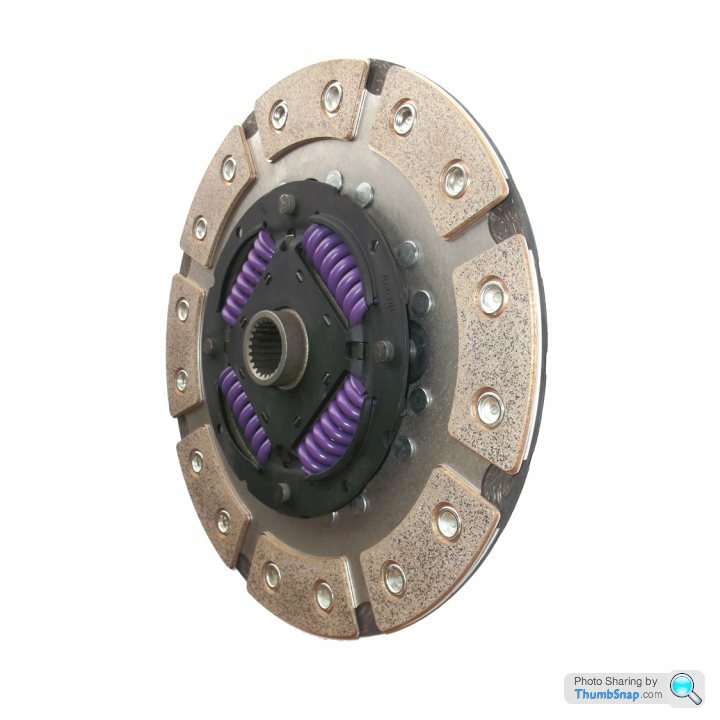Discussion
Does anyone know how (or if) a dual friction clutch works? Or to be more exacting, how it's any better than a 'normal' organic facing on both sides?

To me what kills an organic clutch is when it has been slipped excessively, (too much torque for it to handle), which heats the material to such a state it cannot recover, either that or it just slips under power anyhow making it useless. If that is the case, how does that ^^ make things any better? Surely the organic face will suffer and fail.
It kind of implies that there is a different percentage of 'slippage' (for want of a better word) from the FW to the pressure plate.

To me what kills an organic clutch is when it has been slipped excessively, (too much torque for it to handle), which heats the material to such a state it cannot recover, either that or it just slips under power anyhow making it useless. If that is the case, how does that ^^ make things any better? Surely the organic face will suffer and fail.
It kind of implies that there is a different percentage of 'slippage' (for want of a better word) from the FW to the pressure plate.
PhillipM said:
227bhp said:
That makes no sense 
Why not?
You have two interfaces:
1. Friction disc to FW
2. Friction disc to clutch cover.
So you are implying that there is more torque applied to one than the other? If there is then this thing will work, but how?
PhillipM said:
Well, since the pressure plate and FW are bolted together, it doesn't matter.
So if you slip the clutch a bit as the friction coefficient of the organic is dropping off from the heat, the friction of the sintered will probably be rising into it's operating range.
Of course, that still means you have the crap engagement of the sintered side and the fade of the organic all in one handy package
TL:DR get a full face Kevlar one.
When you slip the clutch (or it slips when overloaded) you would have thought both sides of the friction disc will slip equally, so it will always pick on the organic facing and make that slip - it will still slip overall. I can see maybe there is an advantage from heat, you would expect a standard FW could absorb more heat than the cover.So if you slip the clutch a bit as the friction coefficient of the organic is dropping off from the heat, the friction of the sintered will probably be rising into it's operating range.
Of course, that still means you have the crap engagement of the sintered side and the fade of the organic all in one handy package

TL:DR get a full face Kevlar one.
Kevlar? Yes I was going on to that one next

If the image is a true representation (as opposed to 'library picture') then the pads you see go to the clutch cover.
I'm trying to cut through some of the BS really, what some companies are doing is taking standard clutch covers, spraying them gaudy colours and selling them as uprated or 'Motorsport'.
There are some mods in the package like different friction materials, which will cope with the heat better and grip more effectively, but what they don't seem to be doing is increasing the clamp load which is ultimately what you should do I believe.
Another 'mod' i've seen is they have started putting grooves in the clutch cover like brake discs.
I suppose every bit adds a small % which adds up to a total of X%, much like engine tuning.
But what does kevlar bring to the party? More grip and less effected by the heat probably, but any downsides? There is a long bedding in period with it for some reason.
I'm trying to cut through some of the BS really, what some companies are doing is taking standard clutch covers, spraying them gaudy colours and selling them as uprated or 'Motorsport'.
There are some mods in the package like different friction materials, which will cope with the heat better and grip more effectively, but what they don't seem to be doing is increasing the clamp load which is ultimately what you should do I believe.
Another 'mod' i've seen is they have started putting grooves in the clutch cover like brake discs.
I suppose every bit adds a small % which adds up to a total of X%, much like engine tuning.
But what does kevlar bring to the party? More grip and less effected by the heat probably, but any downsides? There is a long bedding in period with it for some reason.
Edited by 227bhp on Saturday 25th February 14:37
Gassing Station | Engines & Drivetrain | Top of Page | What's New | My Stuff



